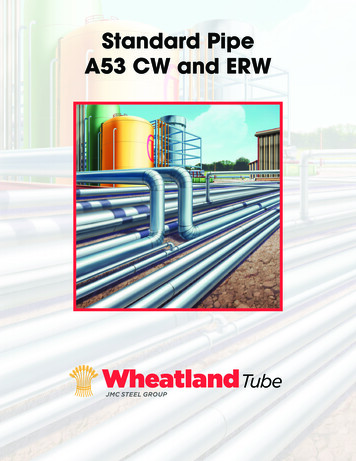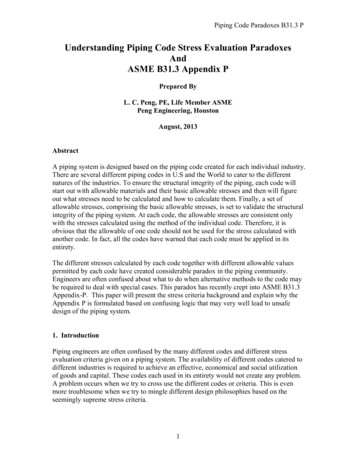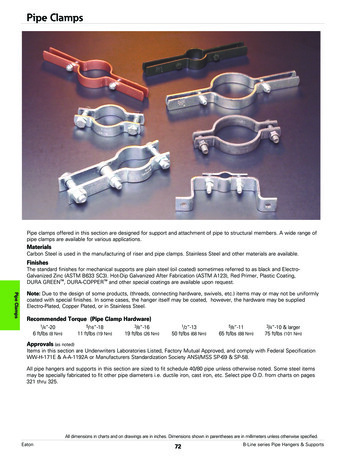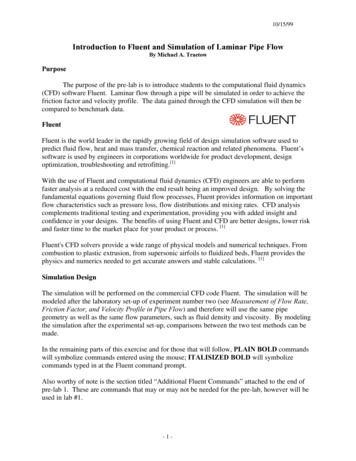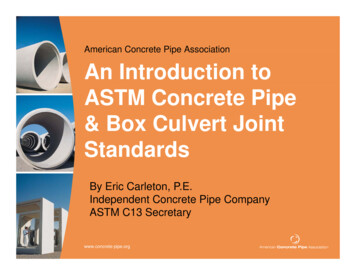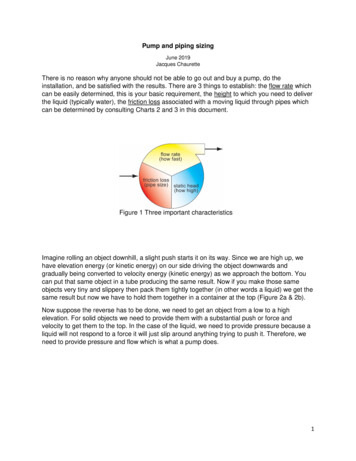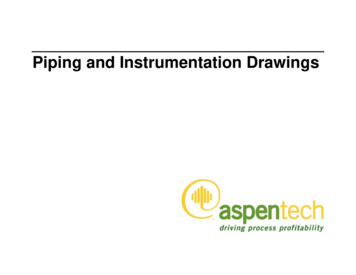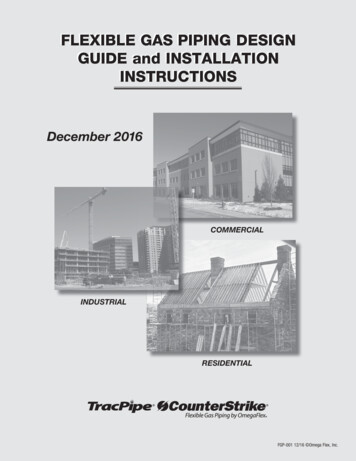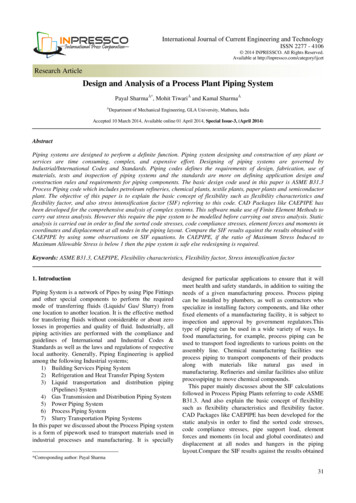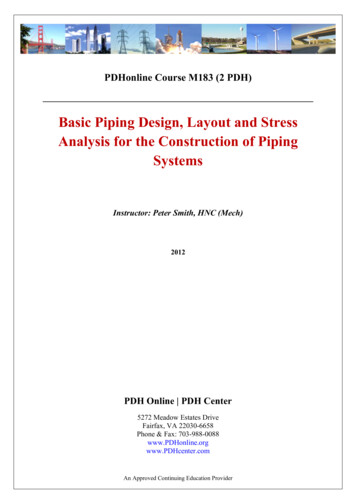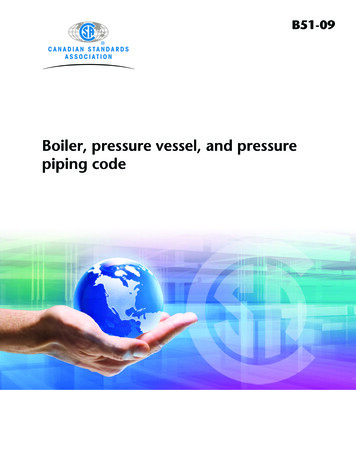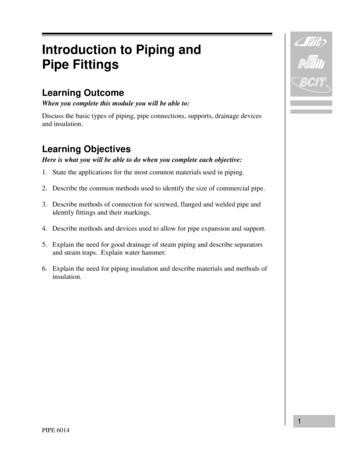
Transcription
Introduction to Piping andPipe FittingsLearning OutcomeWhen you complete this module you will be able to:Discuss the basic types of piping, pipe connections, supports, drainage devicesand insulation.Learning ObjectivesHere is what you will be able to do when you complete each objective:1. State the applications for the most common materials used in piping.2. Describe the common methods used to identify the size of commercial pipe.3. Describe methods of connection for screwed, flanged and welded pipe andidentify fittings and their markings.4. Describe methods and devices used to allow for pipe expansion and support.5. Explain the need for good drainage of steam piping and describe separatorsand steam traps. Explain water hammer.6. Explain the need for piping insulation and describe materials and methods ofinsulation.1PIPE 6014
INTRODUCTIONPiping is used in power plants to convey fluids to and from their place of usageand forms an essential part of the operation of the plant.It is advantageous for the student at Fourth Class level to understand thedifferences between piping requirements for the various fluids concerned, thematerials best to be used, commercial pipe sizes, methods of connectionand fittings.PIPING MATERIALSThe material to be used for pipe manufacture must be chosen to suit the operatingconditions of the piping system. Guidance in selecting the correct material can beobtained from standard piping codes. As an example, the ASME Code forPressure Piping contains sections on Power Piping, Industrial Gas and Air Piping,Refinery and Oil Piping, and Refrigeration Piping Systems. The object being toensure that the material used is entirely safe under the operating conditions ofpressure, temperature, corrosion, and erosion expected.Some of the materials most commonly used for power plant piping are discussedin the following sections.SteelSteel is the most frequently used material for piping. Forged steel is extensivelyused for fittings while cast steel is primarily used for special applications. Pipe ismanufactured in two main categories - seamless and welded.Cast IronCast iron has a high resistance to corrosion and to abrasion and is used for ashhandling systems, sewage lines and underground water lines. It is, however, verybrittle and is not suitable for most power plant services. It is made in differentgrades such as gray cast iron, malleable cast iron and ductile cast iron.Brass and CopperNon-ferrous material such as copper and copper alloys are used in power plants ininstrumentation and water services where temperature is not a prime factor.2PIPE 6014
COMMERCIAL PIPE SIZESCommercial pipe is made in standard sizes each having several different wallthicknesses or weights. Up to and including 304.8 mm pipe, the size is expressedas nominal (approximate) inside diameter. Above 304.8 mm, the size is given asthe actual outside diameter.All classes of pipe of a given size have the same outside diameter, with the extrathickness for different weights on the inside. For example, if a pipe wasdesignated as 152.4 mm size this would mean that it has a nominal orapproximate inside diameter of 152.4 mm. The outside diameter is 168.28 mm.This is a constant value no matter what the wall thickness is. The actual insidediameter of the pipe will depend upon its wall thickness. For a standard wallthickness, the actual inside diameter of 152.4 mm pipe is 154.06 mm. For an extrastrong wall thickness, the actual inside diameter is 146.34 mm.There are two systems used to designate the various wall thicknesses of differentsizes of pipe. The older method lists pipe as standard (S), extra strong (XS) anddouble extra strong (XXS). The newer method, which is superseding the oldermethod, uses schedule numbers to designate wall thickness. These numbers are10, 20, 30, 40, 60, 80, 100, 120, 140 and 160. In most sizes of pipe, schedule 40corresponds to standard and schedule 80 corresponds to extra strong.AK 1 0 1a.jpgGAK 1 0 1b.jpgGAK 1 0 1c.jpgGTable 1 lists the dimensions and the mass in kg/m of different sizes of steel pipewith varying wall thicknesses.METHODS OF CONNECTING PIPEThere are three general methods used to join or connect lengths of pressurepiping. These include:1. Using threaded pipe and screwed connections.2. Using flanges.3. Using welded joints.Each of these methods has certain advantages and disadvantages and each will bediscussed in the following sections.3PIPE 6014
Note: Upper figures are wall thickness in millimetres.Lower figures are mass per metre in kilograms.Table 1Dimensions and Masses of Steel PipeScrewed ConnectionsWith this method, threads are cut on each end of the pipe and screwed fittingssuch as unions, couplings, and elbows are used to join the lengths. This method isgenerally used for pipe sizes less than 101.6 mm for low and moderate pressures.It has the advantage that the piping can be easily disassembled or assembled.However, the threaded connections are subject to leakage and the strength of thepipe is reduced when threads are cut in the pipe wall.4PIPE 6014
Fig. 1 illustrates various screwed fittings that may be used when fabricatinga pipe system.AK 1 0 2.jpgGAK 1 0 4.jpgGAK 1 0 5.jpgGAK 1 0 6.jpgGFigure 1Threaded Pipe FittingsThe purposes of the fittings illustrated in Fig. 1 may be generally statedas follows:Elbows - for making angle turns in piping.Nipples - for making close connections. They are threaded on both ends with theclose nipple threaded for its entire length.Couplings - for connecting two pieces of pipe of the same size in a straight line.AK 1 0 46.movVUnions - for providing an easy method for dismantling piping.Tees and Crosses - for making branch line connections at 90 .AK 1 0 9.jpgGY-bends - for making branch line connections at 45 .Return Bends - for reversing direction of a pipe run.Plugs and Caps - for closing off open pipe ends or fittings.5PIPE 6014
Bushings - for connecting pipes of different sizes. The male end fits into acoupling and the smaller pipe is then screwed into the female end. The smallerconnection may be tapped eccentrically to permit free drainage of water.Reducers - for reducing pipe size. Has two female connections into which thedifferent sized pipes fit. May also be made with one connection eccentric for freedrainage of water.When making up a piping system with screwed connections, it is necessary to cutthe pipe into the required lengths and then thread the ends onto which the fittingswill be screwed.The pipe is supplied from the manufacturer in standard lengths and may be cut tothe required length by means of a pipe cutter. The type of cutter usually employedconsists of a cutting wheel and adjustable guiding rollers as illustrated in Fig. 2.AK1 fig2.gifFigure 2Pipe Cutter(Courtesy of Ridge Tool Co.)When pipe is cut with a wheel and roller cutter, a burr is left on the inside of thepipe and a shoulder is formed on the outside of the pipe. The external shouldermay be removed by filing and the internal burr is removed with a special toolknown as a pipe reamer, which is illustrated in Fig. 3.Figure 3Pipe Reamer(Courtesy of Ridge Tool Co.)6PIPE 6014
It is extremely important that the internal burr be removed completely otherwise itwill tend to catch foreign material passing through the pipe and an obstructionwill be formed.After the pipe has been cut to the proper length, reamed, and the external shoulderremoved, the threads are cut on the pipe ends. The threads are cut by means of aset of cutters known as dies, which are held in a frame known as a stock. Thesemay be moved around the pipe by means of a hand driven ratchet lever or else apower driven machine is used to turn the pipe while the dies are held stationary.The ratchet type dies are shown in Fig. 4 and the power driven threading machinein Fig. 5.AK1 fig4.gifAK 1 0 45.movVFigure 4Ratchet Pipe Dies(Courtesy of Ridge Tool Co.)AK1 fig5.gifFigure 5Power Driven Threading Machine(Courtesy of Ridge Tool Co.)7PIPE 6014
Flanged ConnectionsThis method uses flanges, which are bolted together, face to face, usually with agasket between the two faces. Flanged connections have the advantage overwelded connections of permitting disassembly and are more convenient toassemble and disassemble than the screwed connections.There are three general types of pipe flanges used and these are classifiedaccording to the method of attaching to the pipe end. These types are the screwedflange, the welded flange and the loose or lapped Van Stone flange and areillustrated in Fig. 6.Note that two types of welded flanges are shown; the slip-on weld and the weldneck type. In the weld-neck type, the hub of the flange is butt welded to the pipewhereas the slip-on flange is attached by two fillet welds.AK 1 0 10.jpgGAK 1 0 11.jpgGVan Stone flanges are used in piping systems constructed from stainless steel orother costly materials. The flanges in the system are usually of carbon steel. In theVan Stone type, the flange fits loosely on the pipe and the pipe end is lapped overand faced off as shown in the figure. The pipe to be connected is similarly lappedand has a loose companion flange. A gasket is used between the two lapped facesof the pipes.AK 1 0 12.jpgGAK 1 0 13.gifGAK 1 0 14.gifGAK 1 0 15.gifGAK 1 0 16.gifGAK 1 0 17.gifGAK1 fig6.gifFigure 6Pipe Flange Types8PIPE 6014
In order to prevent leakage at flanged connections, the flange faces, which butttogether, would have to be absolutely flat and smooth. While it is theoreticallypossible to grind the faces to this condition, it is a time consuming and expensiveproposition. Therefore gaskets are usually used between flange faces. Gaskets aremade of a comparatively soft material which, when the flanged connection istightened, will fill in any small depressions in the flange faces and thusprevent leakage.Gaskets are made in three general designs. The full-face gasket covers the entireface of the flange and has holes provided for the flange bolts. This is primarily alow-pressure type of joint and is used for joining cast iron to steel flanges. Theflat ring gasket covers the flange face up to the bolt holes in the flange. The ringjoint gasket is an oval ring, which fits in the grooves that are machined in ringjoint flanges. Joint ring gaskets are generally used for high pressure andspecial services.When making up a flanged joint it is important that flange and gasket surfaces beclean and free from any foreign particles. The flanges must be carefully aligned sothat the flange faces fit together properly. The bolt threads should be lubricatedand then the nuts screwed on by hand as far as possible. When pulling up with awrench, the bolts should not be tightened in rotation, but the cross-over methodshould be used where opposite bolts around the flange are tightened gradually andevenly. A suitable sequence for bolt tightening is shown in Fig. 7.AK 1 0 18.jpgGAK 1 0 19.jpgGAK 1 0 20.jpgGAK 1 0 48.movVAK 1 0 44.movVAK 1 0 40.jpgPFigure 7Bolt Tightening Sequence9PIPE 6014
Welded ConnectionsIn this method, the pipe lengths are welded directly to one another and directly toany valves or fittings that may be required. The use of these welded joints forpiping has several advantages over the use of screwed connections or flangedconnections:1. The possibility of leakage is removed with the elimination of screwed orflanged joints.2. The weight of the piping system is reduced due to the elimination ofconnecting flanges or fittings.AK 1 0 3.jpgGAK 1 0 7.jpgGAK 1 0 8.jpgG3. The cost of material and the need for maintenance are reduced with theelimination of flanges and fittings.4. The piping looks neater and is easier to insulate with the elimination ofbulky flanges and fittings.5. Welded joints give more flexibility to the piping design as the pipes maybe joined at practically any angle to each other.The main disadvantage of using welded joints for piping is the necessity ofobtaining a skilled welder whenever a connection is to be made.Piping of 50.8 mm (2 inch) size and smaller when welded is usually socketwelded. The couplings, valves and other fittings have a recessed portion intowhich the pipe fits and the weld is made around the socket edge. This method isillustrated in Fig. 8.AK1 fig8.gifFigure 8Socket Welding ElbowsFor larger sizes of pipe the pipe ends are butt welded together or butt welded tovalves or fittings. When this method is used, the edges of the pipes or fittings arebevelled to form a groove for depositing the weld metal. Backing or back uprings, which fit inside the pipe at the weld, are used to aid in the lining up of thepipe and also to prevent weld metal from protruding down inside the pipe. Thismethod is shown in Fig. 9.10PIPE 6014
Figure 9Butt Weld Groove With Backing RingIDENTIFICATION OF FITTINGSIn order to insure that valves, fittings, flanges, and unions are of the properstrength and material for the particular service for which they are used, it isnecessary that they be clearly marked or identified.ALL FITTINGS NOT PROPERLY OR CLEARLY IDENTIFIED SHOULD BEREJECTED.All markings, which shall be legible, must indicate the following minimumrequirements:1. Manufacturer’s name or trade mark.2. Service designation, for example, pressure-temperature rating for whichthe fittings is designated.3. Material designation, for example, steel, cast, malleable or ductile iron,and ASTM No.The above markings are listed according to the degree of importance, however,for cast and ductile iron fittings (2) and (3) will be reversed in order since thematerial identification is more important than the service designation.The following is a partial list of material markings with their abbreviation symbolor identification system:Malleable Iron - “MI”Cast Iron - not required for gray cast ironDuctile (Nodular) Cast Iron - “Ductile” or “DI”Carbon Steel - “Steel” or ASTM Specification No. and GradeAlloy Steel - Grade Identification symbol and steel or ASTM No.11PIPE 6014
The follow
PIPE 6014 1 Introduction to Piping and Pipe Fittings Learning Outcome When you complete this module you will be able to: Discuss the basic types of piping, pipe connections, supports, drainage devices and insulation. Learning Objectives Here is what you will be able to do when you complete each objective: 1. State the applications for the most common materials used in piping.
